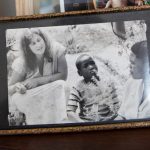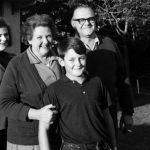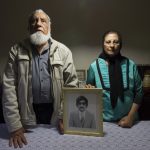Part two | The killing of an unassuming activist
In this second of a three-part series, activist Clare Stewart’s murderers fall through the cracks as apartheid comes to an end and the nation focuses on reconciliation.
Author:
13 February 2020

In the early hours of the morning of 18 November 1993, a week after Clare Stewart had been pronounced missing and a week before her body was found, negotiators from across South Africa’s political spectrum signed off on an interim constitution that would ultimately guide the transition from apartheid to democracy.
After two years of fraught negotiations at Johannesburg’s World Trade Centre, members of the ANC who were present greeted the passage of the 223-page document with cries of “Amandla!”. Conservative Party members of Parliament heckled the government benches and called then president FW de Klerk a “traitor”, then rose to sing Die Stem.
“Now, for the first time, the future holds the promise of a brighter tomorrow,” incoming president Nelson Mandela said, in a typically sunny statement issued from ANC headquarters Luthuli House a little later that morning.
Related article:
However, in KwaZulu-Natal, the threat of an all-out civil war continued to loom large, with Inkatha Freedom Party (IFP) leader and ANC turncoat Mangosuthu Buthelezi among a coalition of hardline leaders who’d boycotted the constitutional process.
As chief minister of the so-called KwaZulu homeland, Buthelezi feared that the ANC’s aim to do away with divisive ethnic politics would erode his own hold on power and privilege in the region, which had largely depended on the apartheid government’s support.
Since the start of November, there had been at least two major IFP paramilitary training camps in the north of what was then still Natal province, and the month’s death toll from clashes between the ANC and IFP was already in the hundreds.
Even after South Africa’s feted first democratic elections in April 1994, Mandela would still feel compelled to call for United Nations intervention in KwaZulu-Natal, as the IFP clamoured for greater autonomy from the ANC government. The South African army was also deployed to various provincial flashpoints to try to mitigate the violence.
But all of this would gradually be subsumed into the necessarily reductive reconciliatory narrative and utopian promise of the so-called “new dawn”. And Stewart’s death, like many others in KwaZulu-Natal around that time, would ultimately fall through the cracks of the seismic changes from which democratic South Africa was being wrought.
“A lot of things were just pushed under the carpet,” said Jenni Irish-Qhobosheane, who worked as a violence monitor in KwaZulu-Natal in the early 1990s and is now a researcher with the Global Initiative Against Transnational Organised Crime, “and a lot of important issues were not properly addressed.”

Red flags
Stewart’s murder investigation fizzled out without a single arrest, let alone a prosecution. A notably vague investigation report, signed by a warrant officer at the Newcastle Murder and Robbery Unit called Andre van der Westhuizen ahead of a brief inquest in June 1995, concluded that “although investigations are carried out thoroughly and impartially, this office is at this time in no position to speculate around the motive for the abduction and subsequent murder of the victim”.
Stewart’s family, meanwhile, remained convinced that her murder had been politically motivated and that the local police force, which continued to be beset by a number of rogue conservative elements during the transition, was likely complicit.
Related article:
A certain Captain Erasmus, who worked alongside Van der Westhuizen on Stewart’s case, aroused particular suspicion. He was routinely unavailable when her family members went to the police station in Empangeni to follow up on proceedings.
It later transpired that Erasmus was facing litigation for assaulting Sipho Cele, the father of Stewart’s second child, Puleng, just months before Stewart’s abduction. He’d also previously been censured in court in 1992 for covering up the misdeeds of fellow officers at the precinct.
But for all the red flags around Stewart’s case, her family, most of whom shared similar political leanings and social consciences, were loath to push for the murder of a white woman to be prioritised at a time when so many black South Africans were desperately seeking justice for their own lost loved ones.
“We didn’t want to jump ahead of anyone, so we sort of let things slide and waited for the new dispensation to deal with it,” said Peter, one of Stewart’s two older brothers, now a professor in Unisa’s department of development studies.
“There was a real opportunity for the ANC to show that they were non-racial, to acknowledge that Clare was a white struggle hero who had enormous principle and identification with the working classes and so forth,” he added. “But it never happened.”

Getting nothing
When the Truth and Reconciliation Commission (TRC) began its public hearings in 1996, it offered Stewart’s family a last hope of finding answers to the mystery surrounding her death. Peter and Rachel, Stewart’s older sister, testified at a hearing in the small KwaZulu-Natal town of Mooi River in May 1997. Both of them were still visibly shaken by what had happened to Stewart.
In mid-December that same year, just over four years after Stewart’s death, the TRC reopened her case for special investigation. Two of the commission’s seasoned investigators, Gail Wannenburg and Erik Kjaergaard, set off for northern KwaZulu-Natal armed with a list of potential witnesses and alleged suspects.
In a small and overwhelmingly black rural town like Manguzi, the investigators expected there would be plenty of murmurings among locals about what had happened to Stewart. But any such hopes were soon tempered by frequent stonewalling and a pervasive climate of fear.
Related article:
“A major difficulty in relation to this case is that it is alleged that serving policemen in the area are implicated in the murder and witnesses are consequently terrified to come forward,” Wannenburg wrote in her investigation report, which was submitted on 8 March 1998.
“It is also alleged that policemen have warned witnesses not to speak to investigators at the cost of their lives,” she added.
Wannenburg came to share Stewart’s family’s sense that Erasmus and Van der Westhuizen were deliberately uncooperative when approached for assistance in the TRC investigation. Furthermore, she discovered that the weapon in Stewart’s case had gone missing from the evidence locker, as had the associated paperwork.
“We kept getting referred from place to place looking for it and getting nothing,” Wannenburg said recently.
Despite such stumbling blocks, a raft of possible motives for the killing soon began to emerge, some more credible than others.
No lover’s quarrel
Wannenburg quickly dismissed claims that Stewart’s murder was the result of a lover’s quarrel with Cele’s wife. She also found that there was nothing to support rumours that it had been an internal ANC killing.
Both of these potential motives seemed to have been propagated by the local police in an attempt to deflect from more likely theories. The most pertinent, backed up by a number of witnesses, was that the killing had been a joint hit by members of the notorious Jozini branch of the security police and local IFP members, either to snuff out any potential threat posed by Stewart’s ANC allegiance or to bury sensitive information that she may have obtained working in the area.
Though it was not mentioned in the final report, Stewart’s siblings recalled Wannenburg telling them that a group of young boys had seen four armed men, two white and two black, shoot a white woman at the site where Stewart’s body was later found.
Related article:
The family were also informed that the public road to and from Ingwavuma had been closed for several hours around the alleged time of the shooting. Wannenburg inferred that security police had ordered the closure.
“The whole thing was a similar modus operandi to other activist killings by [the] Special Branch in that area,” Wannenburg said.
Among those was the killing of Mike Mcetywa, the ANC chairperson in Pongola, who was assassinated by a local IFP member on 22 November 1993, just two days before Stewart’s body was found. A co-conspirator who was in custody for a related murder claimed that Mcetywa’s killing had been a joint plan by local IFP leadership and security police.
Wannenburg’s report also noted that shortly after Stewart’s death, various local IFP leaders and businessmen held a feast to celebrate the recent demise of certain ANC targets, including Stewart.
The askari
Wannenburg ultimately proffered as many as 22 possible perpetrators and accomplices in Stewart’s case. But the most consistently cited in witness statements was a Jozini Special Branch police officer named Aubrey Mngadi, an askari who had previously worked for Eugene de Kock’s police “death squad” at the infamous Vlakplaas farm near Pretoria.
Mngadi would later appear in front of the TRC alongside De Kock and nine other Vlakplaas members in connection with the 1985 abduction and killing of Jameson Mngomezulu, who had been helping ANC cadres infiltrate KwaZulu-Natal from Swaziland.
Mngadi was eventually deemed to have made a full disclosure concerning the events and was granted amnesty.
Related article:
However, when Wannenburg and Kjaergaard tried to approach Mngadi in connection with Stewart’s killing, he refused to meet with them.
Given the overwhelming number of cases with which the TRC was tasked (the commission received more than 21 000 written statements), investigators were often reliant on perpetrators voluntarily coming forward with information.
But Wannenburg said that in Stewart’s case it was not surprising that this had not happened, as it was not an overtly political killing and it was therefore unlikely that the perpetrators would have been granted amnesty.
Further stymied by the TRC’s time constraints, Wannenburg’s report ultimately conceded that she and Kjaergaard had been unable to “fully investigate” certain leads and recommended that “the case should be reopened for investigation with a view to a criminal prosecution”.
Moving on
After Stewart’s death, her children, Themba and Puleng, initially both went to live with Rachel in Johannesburg, as she honoured the pact she and Stewart had made that she would look after the children should anything happen to Stewart. However, Rachel was living alone with her 13-year-old son Ben at the time and, still reeling from what had happened to Stewart, struggled to cope with caring for two additional and much younger children. In 1995, two years after Stewart’s death, Themba was sent to Zimbabwe to live with Stewart’s oldest brother John and his wife Kathy.
“It was an excruciating decision for me and for Themba,” Rachel said.
The family had lost touch with Themba’s father, Mostead Venge, but Puleng’s father, Cele, who had attended Stewart’s funeral in Durban with his eldest son, continued to keep in frequent contact with Peter, who occasionally sent him photos of Puleng.
But Cele had long been a heavy drinker, and his alcohol dependency had been exacerbated by his violent encounter with the security police in the months preceding Stewart’s death. “I think that whole thing really buggered him up,” Rachel told me. “He ultimately died from alcoholism when Puleng was about five.”
Meanwhile, many of Stewart’s friends and former colleagues in Manguzi soon moved on, predominantly to Durban, Johannesburg or Cape Town and in one instance, to Australia.
Similarly, most of the alleged perpetrators in Stewart’s murder, as well as in other similar cases in the region, drifted into comfortable anonymity, retiring to isolated farms, transitioning into the new police force or into KwaZulu-Natal’s burgeoning anti-poaching industry.
“Too many sought refuge in silence and non-disclosure,” Yasmin Sooka, a former TRC commissioner who is now the director of the Foundation for Human Rights, said recently. “But you cannot build a new society without having a foundation of truth.”

Red aloes
After he moved to Zimbabwe and enrolled in high school, Themba also sought to distance himself from his mother’s death and assimilate into his new environment.
“In part, it was natural because of the regular moving and readaptation I’d already experienced,” he said from his current home in Cape Town in 2019. Themba, who has a handsome face, long dreadlocks and a kind smile, moved back to South Africa to study when he was 19 and now works in theatre.
“I built particular walls and coping mechanisms. I was defending my emotional self. I was also just trying to fit in,” he added.
But in early 2016, shortly before she died, Stewart’s aunt Anne Hope entrusted Themba with a box of documents pertaining to Stewart’s disappearance and the subsequent police and TRC investigations, as well as an unpublished biography of Stewart she’d written.
“I got a little obsessed. It kind of threw me off balance because it’s something I’ve known my whole life, but I never actually had much information about it,” Themba said.
In 2017, Themba released a play entitled Red Aloes, so called for the cluster of eponymous plants that surrounded the place where Stewart’s body was found. The play dealt with his mother’s death, but also with broader issues of loss and missing memory in post-apartheid South Africa.
“Clare’s death was just a drop in the ocean. There were so many others. So as much as it is a story of personal trauma, it is also one of societal trauma,” Themba said. “I wasn’t alone.”
This is part two of a three-part series.
Read more:







